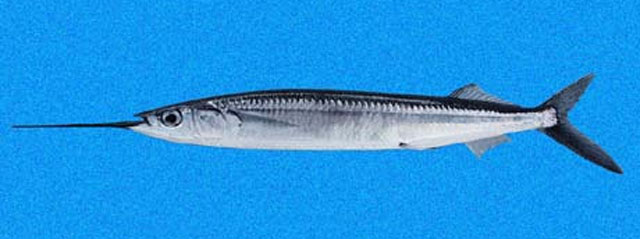| Hemiramphidae (Halfbeaks) |
| 48 cm TL (male/unsexed); max.weight: 223.3 g |
|
pelagic-oceanic; marine; depth range - 0 m, oceanodromous |
| Eastern Pacific: southern California, USA to Panama, including the Galapagos Islands; rare in northern Baja California, Mexico. Range extends to Ecuador (Ref. 36576). |
|
Dorsal spines (total): 0-0; Dorsal soft rays (total): 12-15; Anal spines: 0-0; Anal soft rays: 11-13; Vertebrae: 54-58. Body elongate; lower jaw very prolonged; upper jaw short, triangular, and without scales; lower branch of first gill arch with 26 to 32 gill rakers; fins lacking spines; pectoral fins long; caudal fin deeply forked, the lower lobe longer than the upper; anal fin with 10 to 13 rays; back dark blue; flanks and belly silvery white; edge of lower jaw red; upper lobe of caudal fin violet blue, its tip red (Ref. 55763). Branchiostegal rays: 13-15 (Ref. 36576). |
| An oceanic species which occurs near surface. Adults form very big schools (Ref. 9306). Feed on small fishes and planktonic organisms (Ref. 9306). Oviparous, with planktonic larvae (Ref. 36576). Eggs are attached to floating objects via filaments (Ref. 36576). Found in markets of Panama (Ref. 9306). |
|
Least Concern (LC); Date assessed: 21 May 2007 Ref. (130435)
|
| harmless |
Source and more info: www.fishbase.org. For personal, classroom, and other internal use only. Not for publication.

